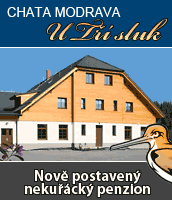Horní Kochánov (German name Ober-Kochet) was the seat of the important royal estate of Kochánov. The first written documents were preserved only from the 17th century, the area was undoubtedly already at the beginning of the 16th century.
For the protection of the borders, the Králováci gained privileges that made them free subjects with the right of self-government. They were formally subordinated directly to the king.
In 1613, the Kochánov rychta had 17 estates, a hundred years later in 1713 it had 23 estates, and another hundred years later 38 estates. The extensive administrative territory included, for example, Keply, Mochov, Žežulka, Busil, Karlov, ...
On the other hand, Dolní Kochánov has always been a vassal village, the first written mention of it dates back to 1294.
According to the census of 1930, the cadastre of the village had 499 inhabitants, together with Dolní Kochánov there were 526 inhabitants, the vast majority of whom were residents of German nationality.
The post-war eviction of native citizens (of German nationality) affected almost all residents of Kochánov, the empty buildings were resettled by Volyn Czechs and Slovaks from Hungary and Romania. But over time they also left the harsh region and the whole area became almost depopulated. In the 21st century, however, the region is slowly waking up. In 2011, permanent residence of 4 residents was reported in Kochánov.
The chapel of Our Lady of Lourdes was consecrated in August 1931. After returning from the battlefields of the First World War, it was built by Johann Leroch, a landlord in Horní Kochanov. The pilgrims' pilgrimage to the chapel always takes place on the last Sunday in May. In 1991, the chapel was renovated with the cooperation of German and Czech believers.
The place where the chapel is located is called "U Zajíčků". An interesting fact is that almost all estates in the area used to have a Czech or honored name before the war, and many local residents also used honored variants of their surnames ("U Solů", "U Kolářů", ...).
From Horní Kochánov, a beautiful view of Sušicko opens up, and the peaks of Brd.
Between the settlement of Keply and Petrovice near Sušice, there is a narrow, almost entire length asphalt road. The entire route and the blue-marked tourist route are also guided along it. There is a 2 km long path from Keplů, suitable for tourists, cyclists and motorists with caution.
Kochánov is one of the stops on the marked Farming Trail from Petrovice. An interesting cycling trip can also be planned from Hartmanice, Hlavňovice or Javorná.
For the protection of the borders, the Králováci gained privileges that made them free subjects with the right of self-government. They were formally subordinated directly to the king.
In 1613, the Kochánov rychta had 17 estates, a hundred years later in 1713 it had 23 estates, and another hundred years later 38 estates. The extensive administrative territory included, for example, Keply, Mochov, Žežulka, Busil, Karlov, ...
On the other hand, Dolní Kochánov has always been a vassal village, the first written mention of it dates back to 1294.
According to the census of 1930, the cadastre of the village had 499 inhabitants, together with Dolní Kochánov there were 526 inhabitants, the vast majority of whom were residents of German nationality.
The post-war eviction of native citizens (of German nationality) affected almost all residents of Kochánov, the empty buildings were resettled by Volyn Czechs and Slovaks from Hungary and Romania. But over time they also left the harsh region and the whole area became almost depopulated. In the 21st century, however, the region is slowly waking up. In 2011, permanent residence of 4 residents was reported in Kochánov.
The chapel of Our Lady of Lourdes was consecrated in August 1931. After returning from the battlefields of the First World War, it was built by Johann Leroch, a landlord in Horní Kochanov. The pilgrims' pilgrimage to the chapel always takes place on the last Sunday in May. In 1991, the chapel was renovated with the cooperation of German and Czech believers.
The place where the chapel is located is called "U Zajíčků". An interesting fact is that almost all estates in the area used to have a Czech or honored name before the war, and many local residents also used honored variants of their surnames ("U Solů", "U Kolářů", ...).
From Horní Kochánov, a beautiful view of Sušicko opens up, and the peaks of Brd.
How to get there:
Between the settlement of Keply and Petrovice near Sušice, there is a narrow, almost entire length asphalt road. The entire route and the blue-marked tourist route are also guided along it. There is a 2 km long path from Keplů, suitable for tourists, cyclists and motorists with caution.
Kochánov is one of the stops on the marked Farming Trail from Petrovice. An interesting cycling trip can also be planned from Hartmanice, Hlavňovice or Javorná.
Mapa
(c) Text & foto: ŠumavaNet.CZ














